
An ancient society near the southern shores of Lake Titicaca in modern-day Bolivia was once one of the continent's most powerful civilizations. Known as Tiwanaku, the ancient society is one of the earliest examples of civilization in the Andes.

The ancient monument of Göbekli Tepe in Türkiye is truly one of the most magnificent ancient marvels on our planet. The temple complex that thrived as a cultural epicenter more than 10,000 years ago is the oldest monument of its kind.

Hidden deep in southern Venezuela, archaeologists have uncovered glyphs, pictograms, and other symbols, left behind thousands of years ago, at around 20 different sites, carved and painted in caves and on boulders.

Researchers say they've used cutting-edge gravitational wave research to shed new light on a nearly 2,000-year-old mystery.

Researchers peering back through 800 years of history have concluded that Mayan civilizetion may well have been undone by drought.

Made some 3,000 years ago, the Mesopotamian bricks contain grains of iron oxide that, to the right interpreter, reveal fascinating changes in the magnetic field that runs through and envelops Earth in a protective barrier.

Down the deep and dark passageways of Mexico's mysterious underwater labyrinth, known for preserving incredible Maya relics, dwells a staggering wealth of microbial life.

A pyramid hidden within a hill on an island in West Java, Indonesia, could be the world’s oldest. Gunung Padang, also known as “mountain of enlightenment”, sits at the top of an extinct volcano and is considered a sacred site by locals.

Severe drought in Brazil has caused river levels to plummet, revealing rock carvings of human faces made up to 2,000 years ago.

The world's most diverse forest, the Amazon, may also host more than 10,000 records of pre-Columbian earthworks (constructed prior to the arrival of Europeans), according to a new study.

In Egypt, a number of mysterious inscriptions and examples of rock art have been found in the Sinai. It is estimated that some of the images could be 12,000 years old.